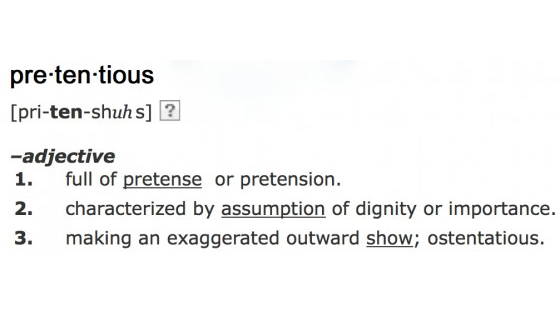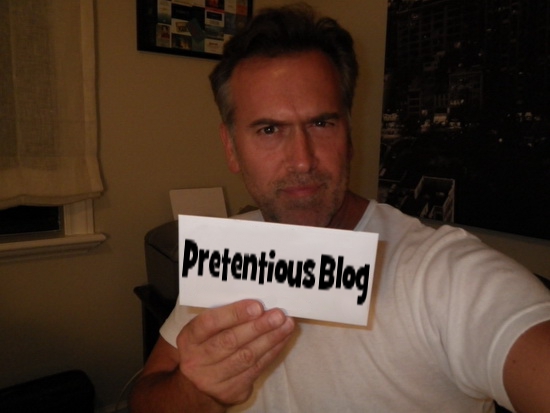Opinions Vary: Pretentiousness, Thy Name Is Art
I don’t think I am postulating anything profound when I say a major aim of criticism is to evaluate a piece of art in a way that is enlightening (if not slightly edifying), allowing the audience to not only experience a fresh perspective on the value and meaning of that work in question, but also offering them a chance to see what that critic values in meaningful art. A review is as much an assessment on the reviewer who views a work of art as it is a review of the work. Sure, it may be a secondary source to the piece and, by extension, inextricably connected to the thoughts of the artist who created it, but the work of criticism instantly becomes a primary source for that critic who has those thoughts on that artist and art piece. First and foremost, we learn what that critic is thinking when we read criticism, enabling us to get into that person’s mindset (and the better the criticism, the more we want to stay there, or take those thoughts with us).
Likewise, this week’s OV piece on criticism is a reflection of my thoughts on the way I think criticism should be conducted, which leads me to my contention. I have a pet peeve that I feel compelled to articulate: I am not a fan of using the word “pretentious” to describe a work of art. That goes for any and all art. And beyond specifically dealing with the word itself in this article, you probably won’t catch me using it. I think it has very little utility in criticism because all art is pretentious.
For an operational definition (that draws from the pic above), so that we’re all on the same page, the “pretentiousness” (because pretense and pretension don’t have enough letters, in my estimation) I’ll settle with is “a claim to distinction or importance, especially one that is exaggerated or unjustified.”
Now, certainly everyone has a right to their own opinion, but I can’t help thinking that this label of pretentiousness is redundant. Any artistic work makes some sort of claim to distinction and/or importance; if it didn’t, it wouldn’t have been made in the first place. Before setting out to make artistic works, the most fundamental stage of the creative process is for artists to believe that they have something worth saying, something important to express that’s distinct enough to be presented to the world, and that that message is best conveyed through the arts. Critics ought to be more aware of this fact, because even though they only factor into this creative process (at least, one hopes) once the art is fully formed, when they are assessing the final product, their own need to critique a work follows the same creative process as the artists’: they too believe they have something worth saying, this time about the art. And for this reason, when the term is bandied about without much insight or explanation as to why the art is pretentious (which is too often the case), there’s a lack of self-awareness to these “pretentious” critics that’s off-putting and counter-productive.
Moreover, just as vital as the conviction that one’s art is worth expressing is the conviction that the art is worthy of having an audience. Self-expression is most potent when there are others to witness that personal statement at play in artistic works. And similarly, without this drive to reach an audience, the art goes unseen by the critics, and everything that makes that piece distinct and important to the artist remains unexpressed, because no one can see how the work measures up to other important and distinct works in the grand scheme of things (a job mainly done by the critics). When the art is offered up for an audience, and the artist assumes it is good enough to be evaluated alongside whatever else is out there, the artist doubles down on its own high quality. In that moment, the artist declares its assumed merit, saying, “Look what I can do. Look what I have made. Isn’t it worth your time to see?” And it’s left up to the critics and the viewing public to make heads or tails of it, but pretentiousness isn’t really up for debate anymore. The art exists; therefore, it is pretentious.
Now, there are many intelligent critics who use the word and explain why the art is indeed pretentious to them and, although their arguments are often engrossing, I still find the usage of the word problematic. In almost every review that I’ve read that elucidates why a work of art is pretentious, the detailed accounts boil down to this: the work’s message does not match its means. That is to say, there is unbalance between what the critic believes the artist attempts to say and do with the art and what is actually said and done. And this unbalance is not only distracting, it’s detracting.
For example, if a movie is deemed pretentious, it’s because the message (the story itself and/or its interpreted purpose for existing) obviously conflicts with the means used to bring that message to life (style of dialogue, score, camera angles, etc.). Simply, one is more excessive than the other. When this inconsistency is witnessed by the critic, when one component exceeds the other, then the inherent self-importance of the overall work manifests itself more pronouncedly. And because one aspect is loftier, its heightened quality leads to the whole work being called pretentious. So when a generic narrative is shot or presented in an extravagant way to the critic, it’s pretentious. When a song is layered with effects to make it more robust while the main thrust behind it still remains too simplistic for the critic, it’s pretentious. And when an artist is aspiring for greatness, yet has nothing great to show or say or offer to the critic, it’s pretentious.
This unbalance between message and means makes the work of art showy, ostentatious, and overbearing. It’s just too much, too flashy, tries to do too many things. And, in turn, these critics start to make judgments on the quality of the work in relation to its apparent level of importance: it thinks it’s better than it is. This would be fair criticism except for one thing: even a well-balanced, great work of art does the same thing in its own way. Just as so-called pretentious works of art signal to these critics that an artist is showing off–supposedly using each flourish to point back to the all-mighty artist who is pulling the strings, proclaiming, “Praise me and my good work”–the well-balanced work of art shows off just how superlative it is at balancing its message with its means, a work that reveals an author who knows exactly how to make something so good and cohesive. Even though a well-balanced work’s showiness does not show as much because it’s well-balanced, it’s certainly still there; it’s just a different manifestation. Likewise, the pretentiousness is there because the art is there to be seen and interpreted. And to the “pretentious” critic, the pretentious work simply appears more pretentious than the other, when in fact both are pretentious to their very core.
Ultimately, “pretentious” critics don’t need to use the word because it’s unnecessary, an extra word to go along with what they have been saying all along. When it appears in a review, the artistic work and quality of that work is already negatively appraised; “pretentious” is rarely, if ever, employed positively. And that’s the most important distinction of all: the difference between a pretentious, unbalanced work of art and an unpretentious, well-balanced one is that one is bad and the other is good to the critic. One that thinks it’s better than it is loses out to the one that knows exactly what it is (and it’s of consistently high quality, to boot)–so self-assured, in fact, that it doesn’t have to make its own claim to importance and distinction, especially when the critic is there to make it for the artist and art. Because, when it’s all said and done, a good work, dressed up in fine attire, justifies its inherent pretentiousness while the other, though equally inherent, does not. And since all art, good or bad, is fundamentally pretentious with varying degrees of excesses and unbalances thrown in to throw off some critics, then the term’s usage in a review ends up being nothing more than excessive.





